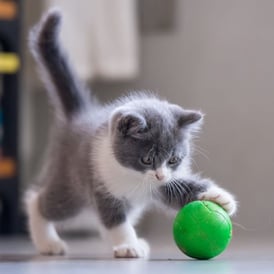Socialization is important for cats of all ages. We’re not necessarily talking about socializing your cat with cats from different households. That can be too intense for many cats. But think of all the other things your cat will be exposed to in their life that could be scary and uncomfortable. That’s what you want to think about when it comes to socialization. How can you make their lives, and by extension your life, easier by setting them up to be confident and comfortable in lots of different situations? Read on to learn how.
Quick Links

Most kittens aren’t adoptable until well into or after the key socialization period, leaving adoptive families without the option to work on socialization during this important time. But that doesn’t mean you’re out of luck.
Cats of any age can still benefit from socialization work. It just needs to be handled with a bit more care and patience because they may have already established negative feelings about the experiences. It’s important to respect those feelings as you work to reverse them.
Our mission is to help save dogs' and cats’ lives through our educational content. To support our efforts, this page may contain affiliate links. We earn a commission for qualifying purchases – at no cost to you.
Socialization is simply a method of exposing your cat or kitten to new things and experiences in a positive way. This helps establish confidence and brave behaviors as they learn new doesn’t mean scary.
Cats who are well socialized are likely to be less skittish and reactive through life. Cooperative care like nail trimming and giving medication can also be much easier on them and you when they’re socialized to that kind of handling in a positive way. It just makes everything better, whether your cat is relaxing at home, exploring a new environment, going to the veterinarian, being groomed at home, and so much more.
You can also desensitize your cat to things they weren’t properly socialized to, even if they’ve already had negative experiences with those things.
These are just some of the things to consider for your socialization list:
Simply bringing new sights, smells, sounds, and sensations into your cat’s daily routine in a positive way will lay the foundation for confident, brave behavior. That ongoing exposure will make them less reactive when new things happen. A confident cat is less skittish, reactive, fearful, even less aggressive, and more friendly.
Whether you’re working with a kitten or an older cat, one thing stands above all else when doing socialization work. Make it positive! Good things should be happening for your cat as they’re exposed to any new thing or experience.
You never want to push your cat past their comfort zone. Don’t give them a reason to put their guard up. Always control the intensity of the exposure. And if your cat seems a little anxious at any point, just turn that intensity down.
Here are a few examples of socializing to new experiences and desensitizing to experiences that already have some negative associations.
These sessions are short — just a few minutes at a time, as long as your cat is willing and interested. The number of sessions it will take depends on many factors. Sometimes it's just a few. Other times it may take several sessions.
Let’s start with a kitten or cat being socialized to gentle restraining, which is important in situations where you need to be able to secure your cat for care or safety.
Within just a few sessions of a few minutes each, you can teach your cat that gentle restraining isn’t just safe and acceptable; it’s great! Moving forward, be sure to give positive reinforcement here and there when your cat responds well to being gently restrained.
Here’s an example where you might be starting fresh with a kitten or cat who has never been exposed to something like taking medication or you may need to reverse a negative association an older cat already has with being medicated.
The best way to look at socialization or desensitization to something like giving medication is to break it up into baby steps.
Find that starting point where your cat is completely comfortable, like seeing the medication in front of them and having your hand touch their face. Baby step them all the way through to being comfortable as you give the medication, rewarding each step in the right direction and slowing down/backing up a few steps if they show even small signs of discomfort.
Think not just about what you’ll be putting in your cat’s mouth but how you’ll need to handle them to accomplish it. And remember, reward each step forward with a treat or something your cat loves.
For example:
Before you know it, you’ve slowly gotten your cat comfortable with a variety of handling and medicating techniques and made lots of positive associations throughout. When the time comes for actual medicating, it will be much easier on you both.
Here’s an example for cats who haven’t spent much time around strangers or visitors to your home. Again, never push past your cat’s comfort zone or force anything. Even if they hide when people come over, that’s OK. You can start working with them while they’re hiding.
It can be as simple as just making good things happen for your cat when people visit — whether that’s giving them a food puzzle or tossing some treats around the room your cat is in, or popping in a few times to toss a toy or have a quick play session. You’re showing your cat that good things happen when this scary thing happens. So, maybe the scary thing isn’t actually all that scary.
When your cat shows brave behavior — from sticking their head out of the door of their hiding room to coming in and greeting the strangers or anything in between — reward them. Pile on the positive reinforcement (whatever makes them happy).
You can do more focused training using techniques similar to the examples above, where you slowly expose your cat to the visitors, pairing each step with treats or other rewards and watching for those signals that you’re moving too quickly.
There’s a common mistake we often make with socialization work or changing a cat’s existing negative associations with something. We push too hard, too fast.
Either we start at a point where they’re already a bit uncomfortable with the thing or we turn up the intensity too quickly and they become uncomfortable. So, start the process where your cat is comfortable and progress slowly.
Another common mistake is thinking a scared cat will get comfortable with something if you just expose them to it for long enough. That’s not the case. True, after a long exposure, they may let their guard down a little because they’re seeing they’re not being injured or attacked by the scary thing. But it’s unlikely that they’ll ever feel truly comfortable with it. They certainly won’t have positive feelings about it, which is what you want – a confident, happy cat.
If your cat is really fearful of something specific and you’re unable to find a starting point where they’re calm enough to start working on the issue, a certified feline training and behavior specialist or veterinary behaviorist can help.
If your cat lives in a heightened state of fear or anxiety, less about a specific item or experience, and more just generally anxious, a behavior professional can help you develop a behavior modification plan to reduce stress and build confidence. And sometimes, anti-anxiety medication or natural calming supplements from your veterinarian can help your cat let their guard down a bit. This is usually best for more severe cases. But it's not a solution on its own. It's still important to pair medication with behavior work to address the root cause of your cat's fear or anxiety.
The Pet InfoRx® is made possible, in part, through our partnership with AlignCare®.


© Preventive Vet. All rights reserved. PreventiveVet.com
